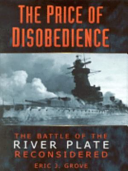General Information – Rio De Plata – 13 Dec, 1939 14:50 (2:50 pm)
This is the historical scenario, early at dawn of the 13th of December 1939, the DKM Graf Spee attack a British Cruiser squadron consisting of HMS Exeter (heavy cruiser) and HMS Ajax and HMS Achilles (light cruisers). The area is just north of the mouth of the Rio de Plata (Ln 35°W Lt 50°S) and it is summer time in the Southern Hemisphere. The breeze is light, 10 kn from SW, the sea is calm (state 1 on the scale of Beaufort) and the sky is empty of any cloud. The visibility start at 15 nm to increase to 25nm thru the day.
preambleText_2 =@”The HMS Ajax has just recovered the Seafox after Lieutenant Lewin landed alongside, you can now increase his speed and cover the starboard side of the DKM Graf Spee in case she change her course toward the high sea. The HMS Achilles is covering the southwest. The Admiralty informed you that HMS Cumberland is steaming toward the river Plata from the Falklands. The HMS Exeter was able to stop the flooding and is slowly sailing toward Port Stanley.”;
German Brief
On your way back to Germany you have decided to raid the merchant traffic off the southern coast of Brazil toward the mouth of the Rio de Plata.
Your orders are to avoid engagement with enemy warship and focus on disrupting merchant traffic, however as you are finishing your Southern Atlantic Campaign you are taking the risk to attack the British merchant convoy protected by a cruiser and 2 destroyers appearing on your SSE horizon. You order battle station ready and set speed to 25knots!
The morning battle report has been reviewed by the headquarter in Germany, the DKM Admiral Sheer and DKM Gneisenau and DKM Scharnhorst will leave harbor and force their way to the North Atlantic. All available U-boot to be reassigned to Atlantic and attack Allied shipping aggressively. Your orders are:
- Fight your way to the high sea.
- If required take to shelter sail to Lagoa dos Patos in Brazil (Porto Alegre has a very large German population)
The axis order of battle:
| Type | Name | Displacement | Speed | Main Armement |
|---|---|---|---|---|
| CA | DKM Graf Spee | Tons 16 000 | kn 28 / 25 (1) | 6 x 280mm |
(1) Practical battle speed due to diesel engines vibrations.
British Brief
You guessed that the German raider will attack the traffic coming from Argentina. Your intuition was right, the elusive German Pocket Battleship is now on the horizon! Your force of one heavy cruiser and 2 light cruisers will have a hard task but the Royal Navy will perform her duty!
The allied order of battle:
| Type | Name | Displacement | Speed | Main Armement |
|---|---|---|---|---|
| CL | HMS Ajax | Tons 8 000 | kn 32 | 8 x 150mm (6') |
| CL | HMS Achilles | Tons 8 000 | kn 32 | 8 x 150mm (6') |

